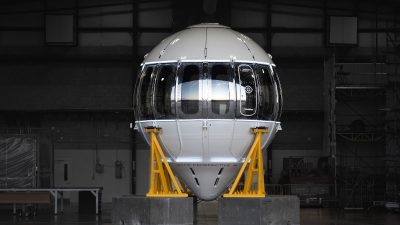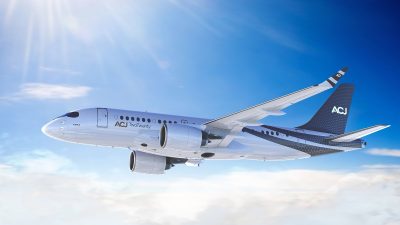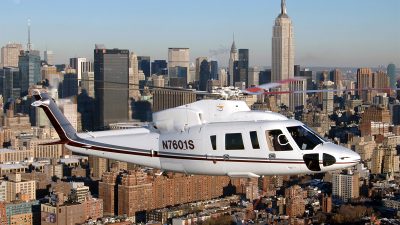Of all the new forms of aircraft propulsion, hydrogen seems unlikely to be the first mover. But Switzerland-based Sirius has announced plans to begin flight testing a hydrogen-powered business jet in 2025.
The company recently introduced the Sirius Business Jet and Sirius Millennium Jet (commercial version), followed by a hydrogen-electric propulsion system with ducted propeller. CEO Alexey Popov provided Robb Report with additional information about development plans and certification timelines.
Like many eVTOL designs, the Sirius business jet will have vertical take-off capability, as well as adjustable rotors to allow forward flight. Like an electric plane, the Sirius Business Jet will emit no carbon dioxide, but its range and top speed will be much greater. “We’ve just unveiled the most important part of this aircraft – the engine,” says Popov.” “This is a sustainable technology that is part of aviation’s plan to become carbon neutral by 2050.”
Hydrogen-powered planes are rare, but not new. In February 1957, a Martin B-57B flew for 20 minutes using one of its engines using hydrogen instead of jet fuel. Exactly 50 years later, Boeing tested the Diamond DA20, a two-seat fuel cell aircraft. In 2016, the wide-and-thin Antares DLR-HY4 experimental aircraft successfully completed hydrogen fuel cell flight testing and has been flying since then. Last January, ZeroAvia flew a Dornier 228 with a single turboprop engine replaced by a prototype hydrogen-electric powertrain consisting of two fuel cells and a lithium-ion battery.
If Sirius is successful, it would be a major breakthrough – the first purpose-built hydrogen-electric jet rather than an experimental aircraft or using an existing airframe. The business jet will not be powered by hydrogen fuel cells, but will instead use liquid hydrogen stored in cryogenic tanks that will power electric motors with a lithium-ion battery system as a backup system.
According to Popov, most of the components use proven “off-the-shelf technologies” and the recently unveiled powertrain is the missing link that ties everything together.
Sirius developed the design of the hydrogen powertrain and ducted fan system, while its partner BMW Designworks is responsible for the interior and exterior design. Tommy Forsgren, Chief Design Officer of the BMW Group, responsible for the BMW 6 Series, will take charge of the design development. The design team has been responsible for the interiors of many large and small aircraft, but this will be its first exterior design. Other partners include the Sauber Group F1 design office and Leonardo Aerostructures, part of Italian helicopter giant AgustaWestland.
The Business Jet version will seat one pilot and up to three passengers, while the Millennial Jet version will seat one pilot and up to five passengers. The design features multi-channel jet propellers with both sets of wings, in the nose and center section of the aircraft, along with a significantly extended tail unit.
Hydrogen has a much higher energy density than batteries, giving it a much longer range than pure electric aircraft. The business jet will be able to fly 1,150 miles thanks to the enlarged fuel tank. Maximum indicated cruising speed is 323 mph. In addition to zero carbon emissions, Sirius claims the aircraft will produce 60 decibels of wind, or a noise level similar to a conversation in a restaurant. The range of the Millennium Jet is about half that of the business jet (650 miles), although its cruising speed and decibel power will be similar.
Major aircraft manufacturers such as Airbus are working on larger hydrogen-powered aircraft, with them expected to be commercially available by 2035.
According to Sirius, a full-scale prototype is currently under construction and is expected to be completed in the second or third quarter of this year. In late 2024, it will undergo initial flight testing and horizontal flight. In 2025, Sirius hopes to produce several full-size airframes and subject them to major flight tests. The electric motor and blade will be developed together.
By the fourth quarter of 2027, Sirius expects to have its aircraft certified by the Federal Aviation Administration, which is seen as its primary market. The long-term plan is to build a plant in the United States, although initial production will be in Switzerland. Popov says, ”We hope to hand over the first aircraft to customers in the first quarter of 2028.”
Sirius said it has received pre-orders for 100 aircraft from Mehair in India at an estimated cost of $400 million. The press release says 50 cars will be made in India and both companies will work on developing a “franchise model” for the country.
If this ambitious experiment ultimately succeeds, Sirius could overtake VTOL competitors who are also considering regional travel. Some expect these new aircraft to replace helicopters for both local and regional travel due to their low noise levels and zero emissions.
But there is still a long way to go before this concept is proven, as announcements have been made of the completion of the first phase. In addition to the propellers and electric motors, careful assembly and flight testing still need to be done. Sirius said it plans to make additional announcements later this month.












